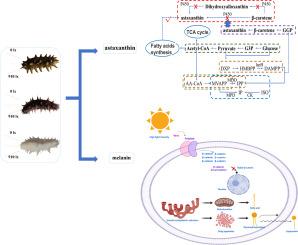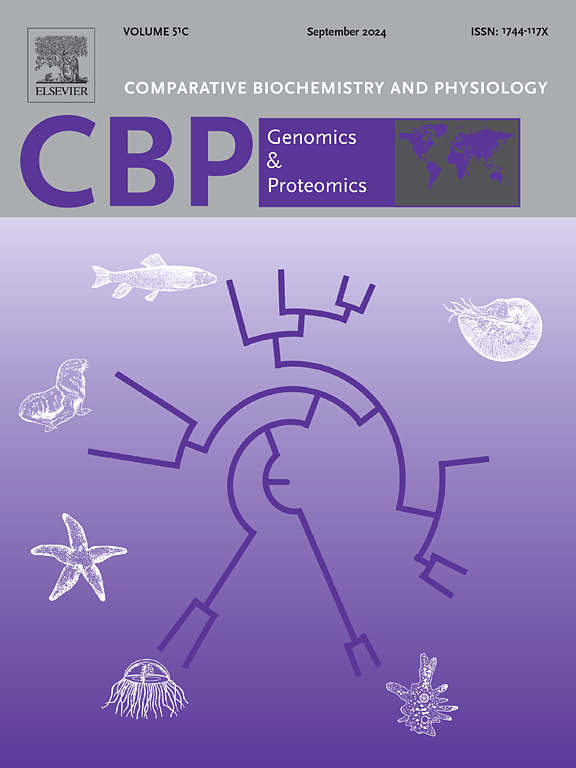Revealing the adaptation mechanism of different color morphs of sea cucumber Apostichopus japonicus to light intensities from the perspective of metabolomics
IF 2.2
2区 生物学
Q4 BIOCHEMISTRY & MOLECULAR BIOLOGY
Comparative Biochemistry and Physiology D-Genomics & Proteomics
Pub Date : 2024-10-29
DOI:10.1016/j.cbd.2024.101346
引用次数: 0
Abstract
Global warming has multi-dimensional and complex impacts on the Earth's system, among which changes in light intensities cannot be overlooked. Sea cucumbers are a marine biological resource with significant economic and ecological value. Their presence and activity help maintain the balance and stability of marine ecosystems. The variation in light intensities have important ecological effects on sea cucumbers. Light intensities can alter the synthesis and degradation of metabolic substances within the bodies of Apostichopus japonicus by changing their body color. Their changes affect the production of microorganisms in the environment, thereby achieving the goal of bioremediation. This study investigated metabolic variations in green, purple, and white sea cucumber Apostichopus japonicus under different light conditions (0 lx and 910 lx) with a 12-h light and 12-h dark photoperiod. The findings indicated that the sea cucumbers displayed more diverse metabolic alterations under 910 lx illumination compared to 0 lx. Specifically, these color morphs primarily responded to changes in light intensities through “tryptophan metabolism” and “biosynthesis of steroid hormones”. Additionally, high light intensities environment exacerbated the consumption of fatty acids by sea cucumbers. Different color morphs of sea cucumbers have differences in key metabolites in response to changes in light intensities. Green and white sea cucumbers primarily adapt to environment through phospholipids, while purple sea cucumbers mainly utilize fatty acids. These results enhance our comprehension of how sea cucumbers adapt ecologically to varying light intensities, and they offer valuable insights for systematically uncovering the regulatory processes that marine animals employ in response to environmental changes.

从代谢组学角度揭示日本刺参不同颜色形态对光照强度的适应机制
全球变暖对地球系统产生了多方面的复杂影响,其中光照强度的变化不容忽视。海参是一种具有重要经济和生态价值的海洋生物资源。它们的存在和活动有助于维持海洋生态系统的平衡和稳定。光照强度的变化对海参有重要的生态影响。光照强度可以通过改变日本海参的体色来改变其体内代谢物质的合成和降解。它们的变化会影响环境中微生物的产生,从而达到生物修复的目的。本研究调查了绿色、紫色和白色海参在不同光照条件(0 lx 和 910 lx)和 12 小时光照和 12 小时黑暗光照周期下的代谢变化。研究结果表明,与 0 lx 光照相比,910 lx 光照下的海参表现出更多样的新陈代谢变化。具体来说,这些颜色形态主要通过 "色氨酸代谢 "和 "类固醇激素的生物合成 "对光照强度的变化做出反应。此外,高光照强度环境加剧了海参对脂肪酸的消耗。不同颜色形态的海参对光照强度变化的关键代谢物的反应也不同。绿色和白色海参主要通过磷脂来适应环境,而紫色海参则主要利用脂肪酸。这些结果加深了我们对海参如何在生态学上适应不同光照强度的理解,并为系统揭示海洋动物应对环境变化的调控过程提供了宝贵的见解。
本文章由计算机程序翻译,如有差异,请以英文原文为准。
求助全文
约1分钟内获得全文
求助全文
来源期刊
CiteScore
5.10
自引率
3.30%
发文量
69
审稿时长
33 days
期刊介绍:
Comparative Biochemistry & Physiology (CBP) publishes papers in comparative, environmental and evolutionary physiology.
Part D: Genomics and Proteomics (CBPD), focuses on “omics” approaches to physiology, including comparative and functional genomics, metagenomics, transcriptomics, proteomics, metabolomics, and lipidomics. Most studies employ “omics” and/or system biology to test specific hypotheses about molecular and biochemical mechanisms underlying physiological responses to the environment. We encourage papers that address fundamental questions in comparative physiology and biochemistry rather than studies with a focus that is purely technical, methodological or descriptive in nature.

 求助内容:
求助内容: 应助结果提醒方式:
应助结果提醒方式:


